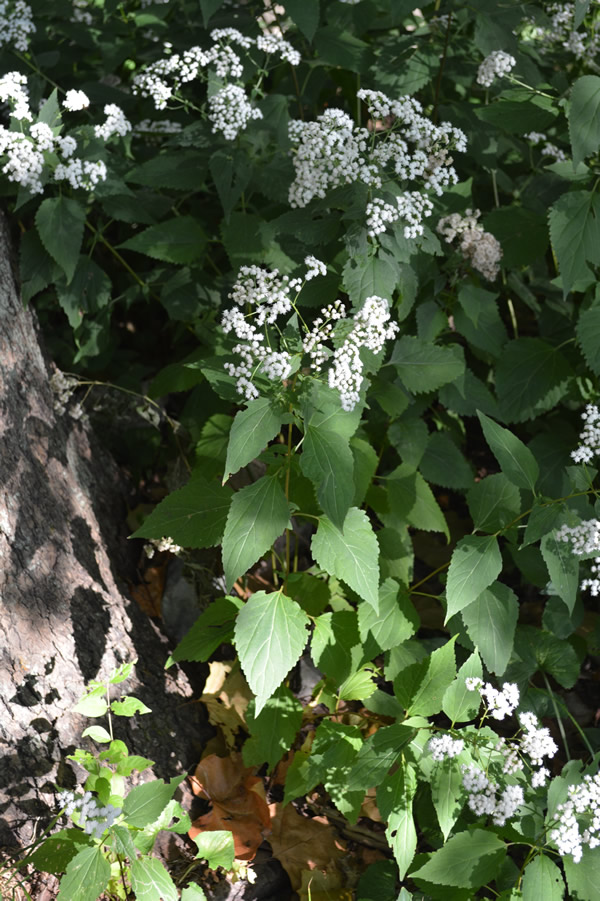Issue 12, September 30, 2019
White Snakeroot
White Snakeroot (Eupatorium rugosum) is a perennial plant in bloom now in central Illinois. It prefers shaded areas and can be found in woodlands, pastures, roadsides, streambeds, and waste places. It can form dense stands.

White snakeroot grows 1 to 3 feet tall. The stem is branched near the top. The leaves are dark green, 2.5-7 in. long, simple, opposite or sometimes whorled, elliptical, thin, with toothed margins, and attached with a slender petiole. Both the stems and leaves are smooth. The flowers are produced July to October. They are small and comprised of bright white, numerous disk flowers only which make them look somewhat fuzzy. They appear in flat-topped clusters. The roots are much branched and fibrous. White snakeroot spreads by seeds and short rhizomes.

It is described by Czarapata as a native plant that sometimes needs control. This plant contains a cumulative poison that causes “trembles” in cattle and horses. Cows that consume this plant produce milk that is toxic to humans unless is it processed or diluted. This “milk sickness” was a serious scourge of the early pioneers and is thought to be the cause of death of Abraham Lincoln’s mother. Fortunately, cattle will typically avoid this plant if there are better sources of food present. Plants can be somewhat easily pulled and removed from the site. This practice should be done prior to seed set.
Some closely related and similarly looking snakeroots include Smaller White Snakeroot (E. aromaticum) with shorter-stalked and thickish leaves and Late-flowering Boneset (E. serotinum) with alternate upper leaves, more broadly lance-shaped leaves, and much taller stems reaching 3-6 ft. The latter is common in Illinois in open, sunny areas and is in bloom now too.
To add to the confusion, there are other plants with snakeroot in their name. Some species of Sanicula include Black Snakeroot, Clustered Snakeroot, Short-styled Snakeroot, and Long-fruited Snakeroot. These plants are in the parsley family and have palmately divided leaves. Button snakeroot is another name for Rattlesnake Master (Eryngium yuccifolium). Sampson’s Snakeroot is another name for Striped Gentian (Gentiana villosa). Seneca Snakeroot (Polygala senega) is a species of milkwort. Virginia Snakeroot (Aristolochia serpentaria) is in the Birthwort family. And finally, Whitesnake is a rock band that was popular in the 1980’s whose songs have been in my head throughout this entire writing.
Sources:
Invasive Plants of the Upper Midwest: An Illustrated Guide to Their Identification and Control by Elizabeth Czarapata
Newcomb’s Wildflower Guide by Lawrence Newcomb
Weeds of Nebraska and the Great Plains by J. Stubbendieck et. al.
Author:
Michelle Wiesbrook